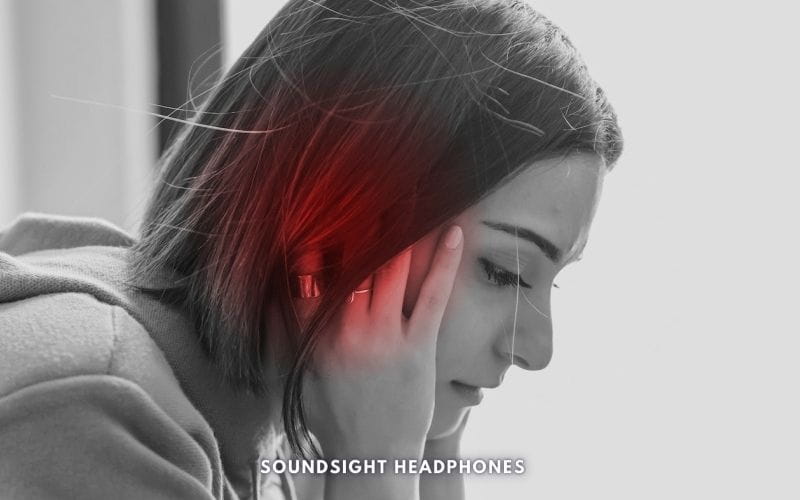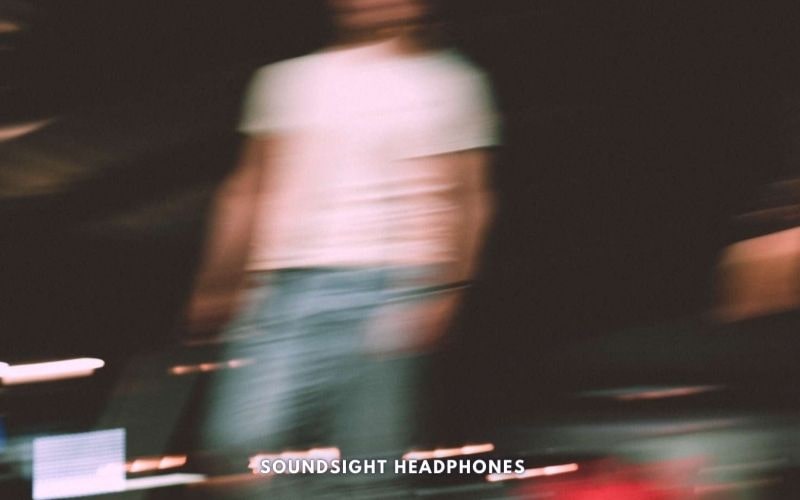Headphones help us escape the world, drown out distractions, and get lost in our favorite tunes, but may also pose risks to our well-being.
I know, I know, it’s a scary thought. But having endured earaches and headaches post extensive listening, I can’t help but ponder potential implications.
So, can headphones be harmful, and if so, to what extend?
In this article, we examine potential headphone health risks, ranging from cancer risks to other harmful effects like hearing loss, Tinnitus, and earwax accumulation. We’ll also discuss how to avoid their harmful effects and preserve ear health while enjoying music happily.
So, grab your headphones (but maybe don’t put them on just yet), and let’s get started!
Headphones Can Cause Negative Effects on Health
Most people will agree that it is important to take preventive measures and avoid harmful habits when it comes to their health. What they might not realize is how wearing headphones can have negative effects on health, indirectly reducing life span or life quality.
So, can headphones be harmful? Yes, they can; here are a few detrimental consequences:
- Hearing impairment
- Vertigo & Dizziness
- Tinnitus
- Hyperacusis
- Heart disease
Hearing Impairment
Extended exposure to loud sounds may cause noise-induced hearing loss (NIHL). That’s right—listening to eardrum-shattering music does more harm than good.
So, let’s dive into the nitty-gritty of NIHL and learn how to protect our ears from deafness.
What’s the Big Deal About NIHL?
Noise-induced hearing loss (NIHL) is no frivolous affair—it’s a rampant issue plaguing millions of unsuspecting ears across the globe. But what’s the real scoop on this auditory impairment?

NIHL is a form of hearing impairment that rears its ugly head when the delicate, microscopic hair cells in our inner ears (specifically, the cochlea) are assaulted by cacophonous sounds. And here’s the kicker—once these hair cells are damaged, they’re down for the count. That’s right—NIHL is often irreversible.
According to a study, there’s been a disturbing uptick in hearing loss among US adolescents between 1988-1994 and 2005-2006. This underscores the burgeoning concern of NIHL in younger populations, who are more likely to be exposed to loud music.
In 2008, another research paper (Y. Agrawal et al. 2008) found that the prevalence of hearing loss among US adults is higher than previously reported, indicating that NIHL is a widespread issue that affects a large portion of the population, making it crucial to raise awareness and promote preventive measures.
How to Listen to Headphones Safely
There are several ways to protect your ears and prevent headphone-related noise-induced hearing loss:
- Reduce volume to a safe level
- Limit usage duration
- Take regular breaks
- Seek professional calibration
For more information, check this article on how to use headphones safely.
Vertigo and Dizziness

Vertigo and dizziness are symptoms caused by a disruption in the inner ear’s vestibular apparatus, which primarily functions to maintain balance, but certain low-frequency sounds from noise-canceling headphones can induce vertigo and dizziness in some individuals.
A study found that headphone users are more susceptible to vertigo. Whereas Eric Dan-Goor & Monica Samra, 2012 identified a case where a woman slept with ANC headphones for 12 hours and experienced an episode of benign paroxysmal positional vertigo (BPPV).
To make matters worse, headphone users can experience vertigo if they are under a certain age, work hours, and years of work experience.
The main takeaway—use noise-canceling sparingly, for example, when traveling or commuting. Moreover, headphones can make you dizzy without ANC during prolonged stationary use.
Tinnitus and Hyperacusis

Constant use of headphone can result in tinnitus—a persistent ear ringing or buzzing—and hyperacusis, increased sensitivity to everyday sounds causing discomfort or pain. Both can result from extreme sound levels or long-term exposure to loud noise.
Sometimes Tinnitus can occur due to excessive sound exposure or trauma; it may resolve in hours or days but can become permanent without proper ear care.
Heart Disease
Loud noise exposure, whether through headphones or other means (such as occupational noise), is associated with a higher risk of cardiovascular diseases like coronary heart disease, hypertension, and myocardial infarction.
Excessive sound exposure has long-term health consequences, as supported by extensive research.
Gan’s 2010 study linked long-term occupational noise exposure to coronary heart disease, especially in young male smokers. This was supported by Kempen’s 2002 meta-analysis, which connected even minor noise exposure to increased hypertension risk. Münzel’s 2014 research associated environmental noise with endothelial dysfunction and arterial hypertension.
Can Earphones be Harmful: Differentiating Between Headphones and Earphones
It’s undeniable—we’ve all experienced the alluring siren call of headphones and earphones. It’s also extremely unfortunate and sad that those compact, versatile, and convenient wearable devices we call earphones are more harmful than headphones.

Some sources and specialists contend that the perceived increased danger of earbuds compared to headphones is a myth, using authoritative appeals to support their safety. The reality is that, even at equal sound pressure levels, due to a closer proximity to the eardrum, earbuds can cause more damage to the ears than headphones.
Studies have found that using headphones and earphones for up to an hour a day can bring on temporary symptoms, and those who listen to portable music players more often and for longer periods may experience higher hearing loss scores.
Long-term use of such devices can adversely affect hearing health. Additionally, increased exposure to ear-damaging frequencies can exacerbate existing ear issues.
Why Earphones Cause More Harm Than Headphones

While the previous discussion focused on headphones, earphones, earbuds, and IEMs have their own unique risks and benefits. This section will explore the potential harm caused by earphones and other types of headphones that insert directly into the ear canal.
Earwax Buildup
The occlusive nature of in-ear headphones can hinder earwax movement, causing cerumen impaction, discomfort, temporary hearing issues, and potentially chronic obstruction and severe ear pain.
Consult an ear specialist for earwax buildup removal.
Ear Infections
In-ear headphones can introduce bacteria, raising ear infection risk. Sharing them may also spread infections. Fortunately, this is less common with over-ear and on-ear headphones.
Various studies note that the number of organisms increases after headsets are worn for an hour (Brook 1992) and frequent, constant use of earphones can increase bacterial growth in both the earphones and the ear (Mukhopadhyay 2008).
Ultimately, regular and thorough cleaning of in-ear headphones and avoiding sharing them are necessary to prevent the spread of bacterial infections. How often you clean your headphones also depends on activity, duration of use, and physical conditions (such as sweating and general ear health).
Allergic Reactions to Silicone or Rubber Tips

Some individuals may experience allergic reactions to the materials used in earphone tips, such as rubber, silicone or foam. This can cause itching, redness, and discomfort in the ear canal.
In contrast, over-ear and on-ear headphones typically use leather that can be processed with chemicals, which may also cause allergic reactions in some individuals.
Takeaway
Earphones pose greater health risks than headphones, as they not only share common issues but also cause earwax buildup, bacterial growth, allergies, inner ear pain, and increased damage to hair cells due to their proximity and the inverse square law.
Wearing Headphones is Bad for Your Head, Neck, Ears, and Hair

Now, let’s move on to the bigger, over-the-ear headphones. While they might not pose the same risk of ear infections, they can still cause some issues:
- Head and neck strain – Heavy headphones can put a strain on your head and neck muscles, potentially leading to discomfort or pain.
- Ear pressure & irritation – Some headphones can create a tight seal around your ears, which may cause pressure and discomfort over time.
- Traction Alopecia and hair damage – Constantly wearing headphones can potentially damage your hair, especially if you have long hair caught in the headband.
Headphones can cause negative effects on health, regardless of volume or music presence. In essence, wearing headphones is bad for your ears, neck, head, and posture, though this depends on their weight, usage duration, and ergonomy.
The Impact on Head and Neck Posture
Wearing headphones for long periods of time can have a strongly negative impact on your head posture and, in some cases, even cause chronic pain.
Headaches
Headaches and fatigue can easily be caused by the heavy weight of certain headphones pressing down on the head while trapping heat.
Neck Pain

Regular, tight-fitting headphones can contribute to neck pain due to the restricted range of motion they can cause.
Jaw Pain
Jaw pain is a potential side effect of headphones that are tight or too heavy for long stretches of time—the extra strain placed on muscles in the jaw and temples can cause tension.
On-ear headphones put less strain on the jaw muscles than over-ear headphones, as they do not fully cover the ears and apply less pressure on the head and jaw area and more on the ear.
Potential Damage to The Ears and Hair
Headphones may cause ear discomfort, irritation, traction alopecia, and pressure-related issues, potentially harming ears and hair.
Hair Loss from Traction Alopecia
The constant friction from over-ear headphones can cause traction alopecia—a gradual hair loss caused by tension on the hair shafts. Wearing headphones can cause hair follicles to disconnect from the scalp, leading to bald spots.

Use in-ear buds or the kind that hook over your ears. Neither comes in contact with your scalp so that you won’t experience any pressure on your hair.
Irritation
On hot days, the combination of sweat, heat, and abrasive ear cushion can cause ear irritation and rashes on the skin of the ear. Eczema and acne are additional side effects of long-term headphone use.
Regular cleaning, wiping out excess sweat every now and then, and using open-back headphones to allow air circulation can prevent these issues.
Some materials that can irritate your ear and lead to ear eczema or rashes are:
- Synthetic fabrics such as polyester
- Non-breathable fabrics such as neoprene rubber or faux leather
- Foam pads and mesh
Materials that can reduce irritation are:
- Covers made from materials like soft leather, sheepskin, velvet, or velour
Ear pain

Prolonged use of headphones can cause earache, aching, and general discomfort in the ears. This pain is often due to the pressure exerted on the ears, leading to soreness and tenderness.
Headphones may cause ear pain from tightness, small contact surfaces, thin padding, earwax buildup, or improper fit, especially with in-ear models. Some ear shapes may not be compatible with in-ear headphones.
Headphones Hurt My Ears Remedy
If headphones hurt your ears or you experience inner pain due to the use of earphones, here are some tips for finding some relief:
- Stretch your headphones
- Adjust the headband
- Buy ear pads with a softer cushion
- Take periodic breaks to reduce ear fatigue.
- Insert the earbuds properly; this entails proper earbud placement by inserting the right earbud into the right ear and vice versa, using the appropriate ear tip size, and inserting the earbuds correctly by twisting them into the ear.

Ultimately, select ergonomically designed, lightweight headphones (<250g over-ear, <150g on-ear) with ample padding and a broad contact surface. Maintain a comfortable volume and take breaks if experiencing ringing ears or heaviness.
Can Headphones Make You Sick?
Okay, but how about any sickness or allergies; could prolonged headphone usage make you sick?
Allergies
Headphones and earphones can cause allergies and induce sickness in some individuals.
Allergic reactions to headphones can manifest in two ways including:
- Irritation—itchiness, redness, or swelling in the ear canal or surrounding skin
- Skin allergies—rashes, hives, or eczema caused by contact with allergens
Common headphone-related allergies are often caused by materials used in their construction, such as silicone, rubber, and substances in leather processing.
Epoxy resin and acrylic ear mold materials (methyl methacrylate, triethyleneglycol dimethacrylate, and urethane dimethacrylate) may also trigger allergic reactions in sensitive individuals.
Ear Infections
Prolonged headphone-wearing creates a warm, moist environment in the ear canal, leading to the growth of bacteria and fungi. This may result in an ear infection.

Symptoms of an ear infection can include pain, discharge, itchiness, and temporary hearing loss.
To reduce the risk of ear infections, practice good ear hygiene, namely:
- Clean your ears regularly
- Clean your headphones/earbuds
- Don’t share headphones with others.
Additionally, you can opt for over-ear headphones instead of in-ear models, as they are more sanitary.
Motion Sickness

As mentioned, motion sickness and dizziness are forms of vertigo and may result from using noise-canceling headphones or prolonged use in stationary positions, such as for call center professionals.
So yes, prolonged use of headphones can make you sick even if adequately cleaned.
Beryllium Headphones

Beryllium, a toxic substance, is used in some premium audiophile headphones’ drivers. Though dangerous as a powder, it’s safe in metal form. Thus, the dangers of beryllium in headphones is limited, provided you avoid ingesting the drivers and know how to dispose beryllium headphones properly.
Wireless Headphones: Safe or Not?
The main concerns regarding the harmful effects of wireless headphones are brain damage, cancer, and wireless radiation.
Though this topic is more thorough and not fully covered here, be assured that none of these health risks apply to you due to the following reasons:
Brain Damage, Cancer & Wireless Radiation

Wireless headphones, using non-ionizing Bluetooth radiation (2.4 GHz frequency), do not cause brain damage or cancer.
With a low power output (50-100 milliwatts), they lack the energy to damage DNA within cells, unlike ionizing radiation from X-rays and gamma rays.

Bluetooth headphones emit significantly lower radiation than cell phones, with no strong evidence of health risks, according to a 2019 study.
Note, though, that while Bluetooth headsets don’t cause cancer and have lower radiation than cell phones, that doesn’t necessarily mean they’re healthy, non-invasive, and safe.
Fortunately, short-term, no negative effects have been identified. Though limited research exists on long-term Bluetooth exposure, says Dr. Joel Moskowitz of UC Berkeley.
It’s still a wise practice to minimize EMF radiation. To do so, concerned individuals can limit Bluetooth headphone usage, opt for speakers, and consult health professionals.
Reasons to Be Cautious
Non-ionizing radiation, which is wireless and radio frequency that most Bluetooth headphones use, doesn’t affect molecules or atoms to result in cancer. However, plenty of studies have shown that long-term exposure to high EMF levels has negative effects:
- A 2018 study revealed that 925 MHz non-ionizing RF-EMF (2.010 µW/cm² or 20.1 mW/m²) negatively impacted motor skills, spatial memory, and attention in adolescents.
- A 2015 study in the International Journal of Environmental Research and Public Health discovered higher glycated hemoglobin levels and type 2 diabetes risk in students exposed to higher RF EMF.
References
- Fatima, Rida et al. “Prevalence of Vertigo in Headphone Users of Call Center of Faisalabad City.” Pakistan Journal of Health Sciences (2022): n. pag.
- Shargorodsky, Josef et al. “Change in prevalence of hearing loss in US adolescents.” JAMA 304 7 (2010): 772-8.
- Agrawal, Yuri et al. “Prevalence of hearing loss and differences by demographic characteristics among US adults: data from the National Health and Nutrition Examination Survey, 1999-2004.” Archives of internal medicine 168 14 (2008): 1522-30.
- Shoukat S. Cell phone addiction and psychological and physiological health in adolescents. EXCLI J. 2019 Feb 4;18:47-50. PMID: 30956638; PMCID: PMC6449671.
- Dan-Goor E, Samra M. Benign paroxysmal positional vertigo after use of noise-canceling headphones. Am J Otolaryngol. 2012 May-Jun;33(3):364-6. doi: 10.1016/j.amjoto.2011.08.012. Epub 2011 Oct 5. PMID: 21978648.
- GONçALVES, C and Fernanda Abalen Martins Dias. “AUDIOLOGICAL FINDINGS IN YOUNG USERS OF HEADPHONES.” (2014).
- Peng, Jianhua et al. “Risk of damage to hearing from personal listening devices in young adults.” The Journal of otolaryngology 36 3 (2007): 181-5 .
- Fatima, Rida et al. “Prevalence of Vertigo in Headphone Users of Call Center of Faisalabad City.” Pakistan Journal of Health Sciences (2022): n. pag.
- Aljuaid, Mossab et al. “Ear-related problems among headphone users in the Kingdom of Saudi Arabia.” Saudi Journal of Otorhinolaryngology Head and Neck Surgery 24 (2022): 27 – 34.
- Brook I, Jackson WE. Changes in the microbial flora of airline headset devices after their use. Laryngoscope. 1992 Jan;102(1):88-9. doi: 10.1288/00005537-199201000-00017. PMID: 1731163.
- Mukhopadhyay, Chiranjay et al. “A comparative analysis of bacterial growth with earphone use.” Online Journal of Health & Allied Sciences 7 (2008): 4.
- Gan WQ, Davies HW, Demers PA. Exposure to occupational noise and cardiovascular disease in the United States: the National Health and Nutrition Examination Survey 1999-2004. Occup Environ Med. 2011 Mar;68(3):183-90. doi: 10.1136/oem.2010.055269. Epub 2010 Oct 5. PMID: 20924023.
- van Kempen EE, Kruize H, Boshuizen HC, Ameling CB, Staatsen BA, de Hollander AE. The association between noise exposure and blood pressure and ischemic heart disease: a meta-analysis. Environ Health Perspect. 2002 Mar;110(3):307-17. doi: 10.1289/ehp.02110307. PMID: 11882483; PMCID: PMC1240772.
- Münzel T, Gori T, Babisch W, Basner M. Cardiovascular effects of environmental noise exposure. Eur Heart J. 2014 Apr;35(13):829-36. doi: 10.1093/eurheartj/ehu030. Epub 2014 Mar 9. PMID: 24616334; PMCID: PMC3971384.
- Meding, B. and Anders Ringdahl. “Allergic contact dermatitis from the earmolds of hearing aids.” Ear and hearing 13 2 (1992): 122-4 .
- Mandalà M, Colletti V, Sacchetto L, Manganotti P, Ramat S, Marcocci A, Colletti L. Effect of Bluetooth headset and mobile phone electromagnetic fields on the human auditory nerve. Laryngoscope. 2014 Jan;124(1):255-9. doi: 10.1002/lary.24103. Epub 2013 Apr 25. PMID: 23619813.
- Meo SA, Almahmoud M, Alsultan Q, Alotaibi N, Alnajashi I, Hajjar WM. Mobile Phone Base Station Tower Settings Adjacent to School Buildings: Impact on Students’ Cognitive Health. Am J Mens Health. 2019 Jan-Feb;13(1):1557988318816914. doi: 10.1177/1557988318816914. Epub 2018 Dec 7. PMID: 30526242; PMCID: PMC6775553.
- Meo, S.A.; Alsubaie, Y.; Almubarak, Z.; Almutawa, H.; AlQasem, Y.; Hasanato, R.M. Association of Exposure to Radio-Frequency Electromagnetic Field Radiation (RF-EMFR) Generated by Mobile Phone Base Stations with Glycated Hemoglobin (HbA1c) and Risk of Type 2 Diabetes Mellitus. Int. J. Environ. Res. Public Health 2015, 12, 14519-14528. https://doi.org/10.3390/ijerph121114519
